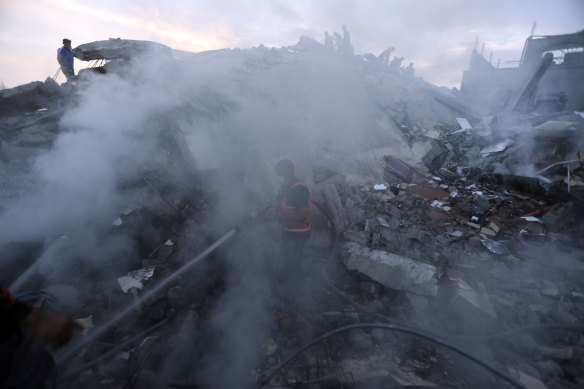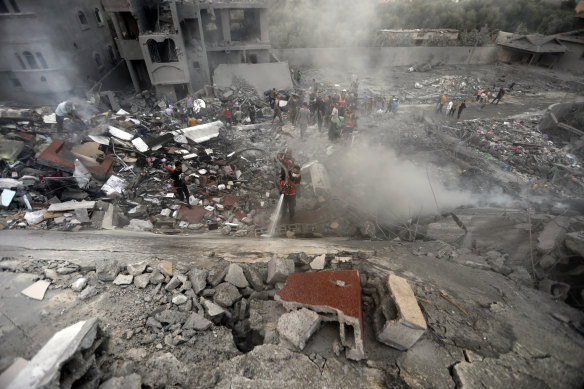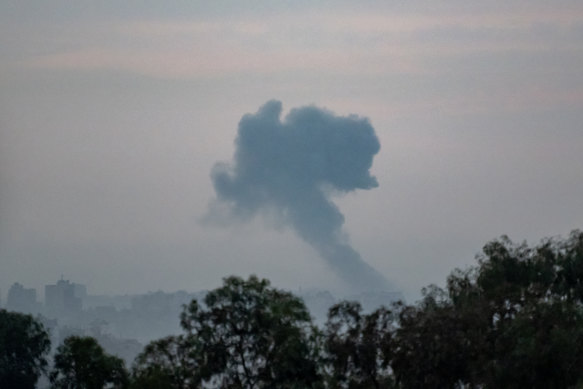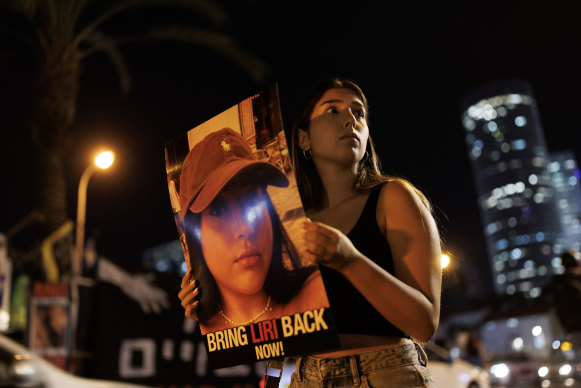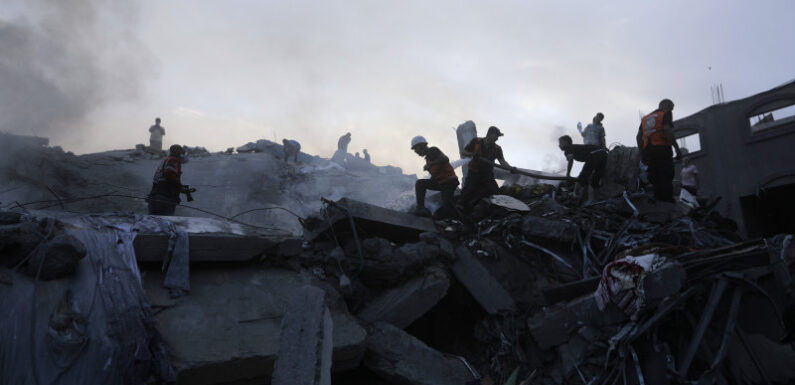
Save articles for later
Add articles to your saved list and come back to them any time.
Key points
- A flurry of Israeli airstrikes on a refugee camp near Gaza City levelled apartment buildings.
- PM Benjamin Netanyahu rejected calls for a cease-fire and again vowed to crush Hamas.
- Israel and Lebanon’s Hezbollah militant group have traded fire daily along the border.
- Iran-backed Houthi rebels in Yemen said they fired ballistic missiles and drones at Israel.
- Hamas’s attack on Israel will inspire the most significant terror threat to the US since ISIS, FBI said.
Khan Younis: A flurry of Israeli airstrikes on Tuesday on a refugee camp near Gaza City levelled apartment buildings, leaving craters where they once stood, as ground troops battled Hamas militants across northern Gaza and attacked underground compounds.
Buoyed by the first successful rescue of a captive held by Hamas, Prime Minister Benjamin Netanyahu rejected calls for a cease-fire and again vowed to crush Hamas’ ability to govern Gaza or threaten Israel following its bloody October 7 rampage, which ignited the war.
Palestinians look for survivors under the rubble of a destroyed building following Israeli airstrikes in Nusseirat refugee camp.Credit: AP
Several hundred thousand Palestinians remain in the northern part of Gaza, where Israeli troops and tanks reportedly have advanced on several sides of Gaza City, the sprawling urban centre.
In the Jabaliya refugee camp on Gaza City’s outskirts, at least six airstrikes destroyed a number of apartment blocks in a residential area, the Hamas-run Interior Ministry said. It reported a large number of casualties but did not immediately provide details.
Footage of the scene from Al-Jazeera TV showed at least four large craters where buildings once stood, amid a large swath of rubble surrounded by partially collapsed structures. Dozens of rescue workers and bystanders dug through the wreckage, searching for survivors beneath the pancaked buildings. A group of young men pulled two children from the upper floors of a damaged apartment block, cradling them as they climbed down.
Palestinians look for survivors under the rubble of a destroyed building following Israeli airstrikes in Nusseirat refugee camp, central Gaza Strip.Credit: AP
More than half the territory’s 2.3 million Palestinians have fled their homes, with hundreds of thousands sheltering in packed UN-run schools-turned-shelters or in hospitals alongside thousands of wounded patients. Israeli strikes have hit closer to several northern hospitals in recent days, alarming medics.
Thousands of people broke into its aid warehouses over the weekend to take food, as supplies of basic goods have dwindled because of the Israeli siege.
There has been no central electricity in Gaza for weeks, and Israel has barred the entry of fuel needed to power emergency generators for hospitals and homes.
UNRWA, which hundreds of thousands of people in Gaza rely on for basic services even in normal times, says 64 of its staff have been killed since the start of the war, including a man killed alongside his wife and eight children in a strike late Monday.
“This is the highest number ever of UN aid workers killed in any conflict around the world in such a short time,” spokesperson Juliette Touma told The Associated Press. “UNRWA will never be the same without these colleagues.”
An incoming Israeli military strike on buildings in Gaza City, as seen from the border area on October in Sderot, Israel.Credit: Getty
The war has also threatened to ignite fighting on other fronts. Israel and Lebanon’s Hezbollah militant group have traded fire daily along the border, and Israel and the US have struck targets in Syria linked to Iran, which supports Hamas, Hezbollah and other armed groups in the region.
The military said it shot down what appeared to be a drone near the southernmost city of Eilat and intercepted a missile over the Red Sea on Tuesday, neither of which entered Israeli airspace.
The Iran-backed Houthi rebels in Yemen later issued a video statement claiming to have fired ballistic missiles and drones at Israel, saying it was the third such operation. They threatened to carry out more strikes “until the Israeli aggression stops.”
Earlier this month, a US Navy destroyer in the Red Sea intercepted three cruise missiles and several drones launched toward Israel by the Houthis, who control much of northern Yemen, including its capital, Sanaa. Projectiles have also struck inside Egypt, near the Israeli border.
In the occupied West Bank, where Israeli-Palestinian violence has also surged, the army demolished the family home of Saleh al-Arouri, a senior Hamas official exiled over a decade ago. Ali Kaseeb, head of the local council in the village of Aroura, said the home had been vacant for 15 years.
The Hamas-run Health Ministry in Gaza said Tuesday it registered the deaths of at least 219 people in the past day, bringing the death toll to 8,525 since the war began.
Spokesperson Ashraf al-Qidra said in a televised news conference that the fatalities include 3,542 children and 2187 women.
Over 1400 people have died on the Israeli side, mainly civilians killed during Hamas’ initial attack, also an unprecedented figure. Palestinian militants have continued firing rockets into Israel.
Larger ground operations have been launched north and east of Gaza City. Jonathan Conricus, an Israeli military spokesman, called Gaza City the “centre of gravity of Hamas” but said strikes continue in other parts of the territory.
Casualties are expected to mount on both sides as the battle moves into dense, residential neighbourhoods.
Conricus said some 800,000 people have heeded the Israeli military’s orders to flee from the northern part of the strip to the south. Northern Gaza was estimated to have a pre-war population of around 1.1 million.
Friends and families of those taken hostage by Hamas gather to call for their return in Tel Aviv.Credit: Getty
Zaki Abdel-Hay, a Palestinian living a few minutes’ walk from the road south of Gaza City, said people are afraid to use it. “People are very scared. The Israeli tanks are still close,” he said over the phone, adding that “constant artillery fire” could be heard near the road.
Dawood Shehab, a spokesperson for Islamic Jihad, a smaller militant group allied with Hamas, told Al Jazeera television that its fighters were battling Israeli forces who were trying to cut off the main highway and a parallel coastal road farther west.
Gaza’s humanitarian crisis, meanwhile, continues to worsen.
The World Health Organisation said two hospitals have been damaged and an ambulance destroyed in Gaza over the last two days. It said all 13 hospitals operating in the north have received Israeli evacuation orders in recent days. Medics have refused such orders, saying it would be a death sentence for patients on life support.
Israel says it targets Hamas fighters and infrastructure and that the militants operate among civilians, putting them in danger.
Israel has allowed more than 150 trucks loaded with food and medicine to enter Gaza from Egypt over the past several days, but aid workers say it’s not enough to meet rapidly growing needs.
FBI Director Christopher Wray.Credit: Getty
Cyprus is working out logistics with partners in the European Union and the Middle East to establish a sea corridor to deliver a stream of vital humanitarian aid to Gaza from the island’s main port of Limassol once the situation on the ground permits it, authorities said on Tuesday.
Iran-backed Houthi rebels in Yemen issued a video statement on Tuesday claiming to have fired ballistic missiles and drones at Israel, saying it was the third such operation. They threatened to carry out more strikes “until the Israeli aggression stops.”
The claims by the Houthis draw Iran closer into the ongoing Israel-Hamas war as Tehran remains a main sponsor.
The attack by Hamas on Israel will inspire the most significant terror threat to the United States since the rise of ISIS nearly a decade ago, FBI Director Christopher Wray said at a congressional hearing on Tuesday.
Wray said that since the start of the Israeli-Palestinian conflict in Gaza earlier this month, multiple foreign terrorist organisations have called for attacks against Americans and the West, raising the threat posed by homegrown US violent extremists.
“The actions of Hamas and its allies will serve as an inspiration the likes of which we haven’t seen since ISIS launched its so-called caliphate several years ago,” Wray said.
The remarks came during a hearing before the US Senate Homeland Security and Governmental Affairs Committee focused on threats to the United States. The US government has seen an increase in threats against Jews, Muslims and Arab Americans since fighting broke out in Gaza, officials have said.
AP, Reuters
More coverage of the Hamas-Israel conflict
- Cascading violence: Tremors from the Hamas attacks and Israel’s response have reached far beyond the border. But what would all-out war in the Middle East look like?
- The human cost: Hamas’ massacre in Israel has traumatised – and hardened – survivors. And in Gaza, neighbourhoods have become ghost cities.
- “Hamas metro”: Inside the labyrinthine network of underground tunnels, which the Palestinian militant group has commanded beneath war-ravaged Gaza for 16 years. The covert corridors have long provided essential channels for the movement of weapons and armed combatants.
- What is Hezbollah?: As fears of the conflict expanding beyond Israel and Hamas steadily rise, all eyes are on the militant group and political party that controls southern Lebanon and has been designated internationally as a terrorist group. How did it form and what does Iran have to do with it?
Most Viewed in World
From our partners
Source: Read Full Article
